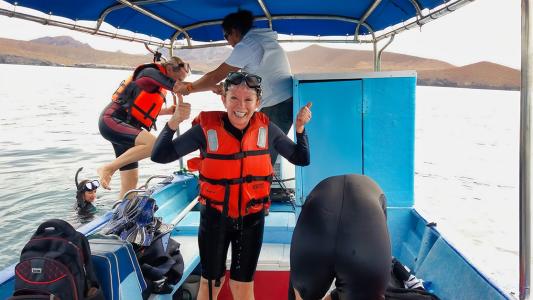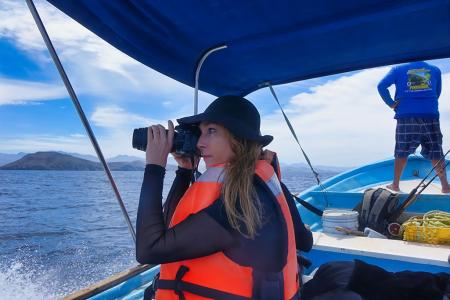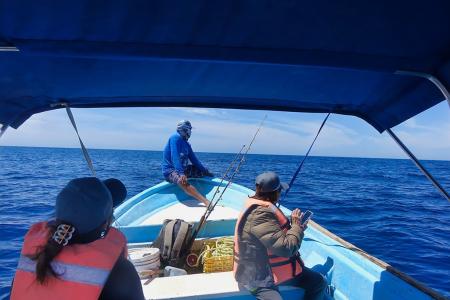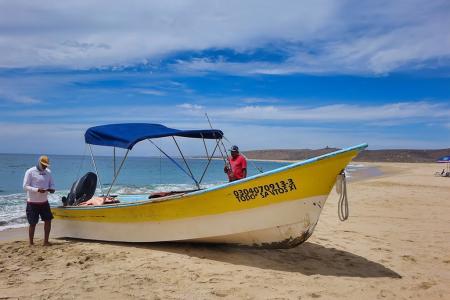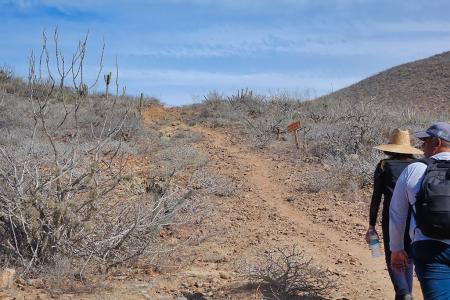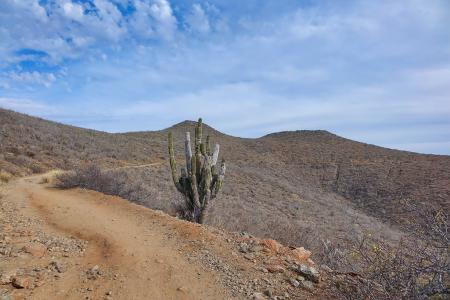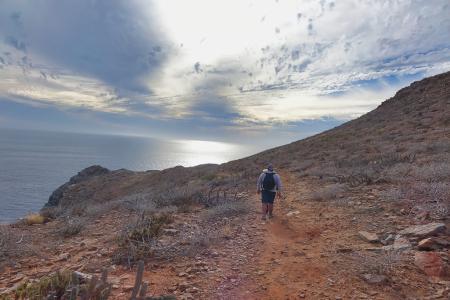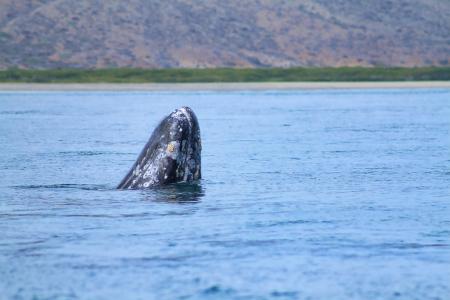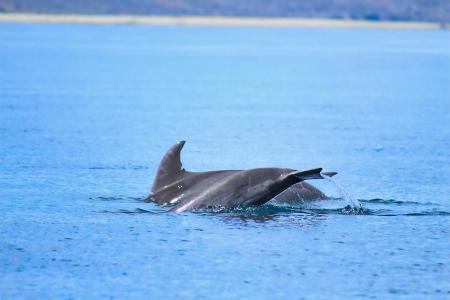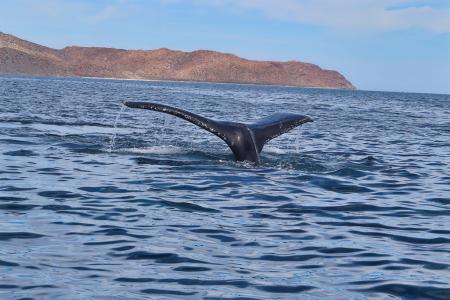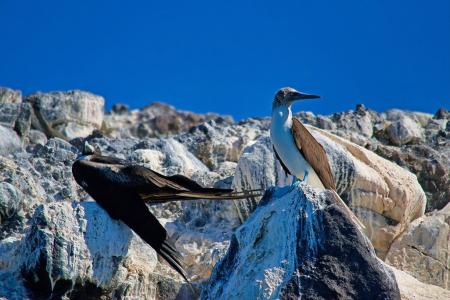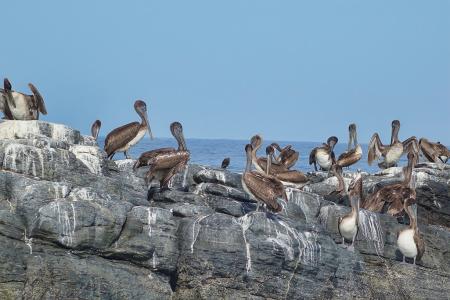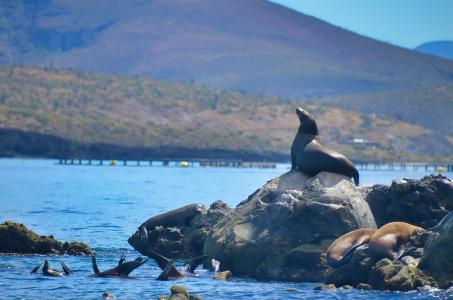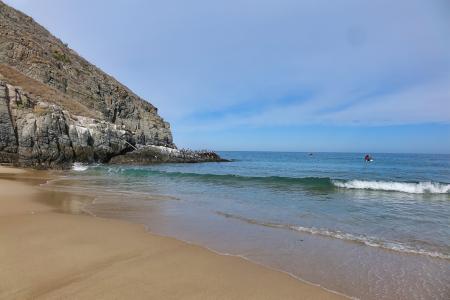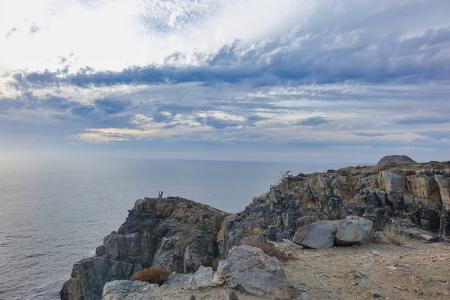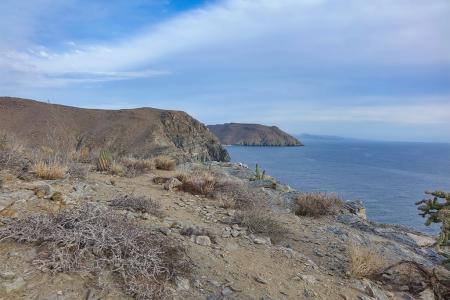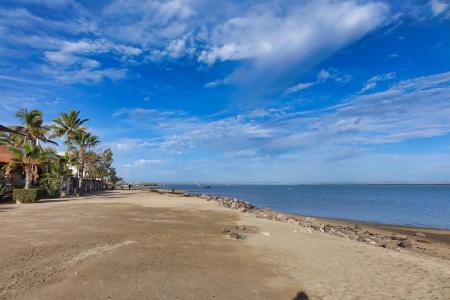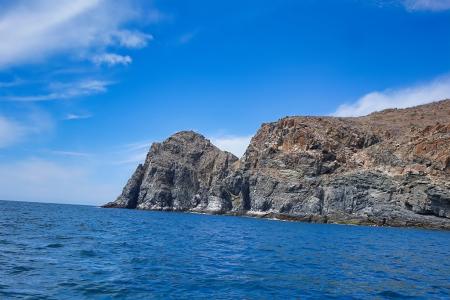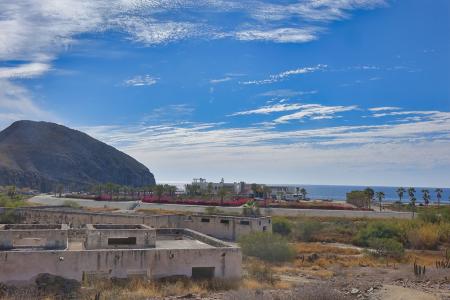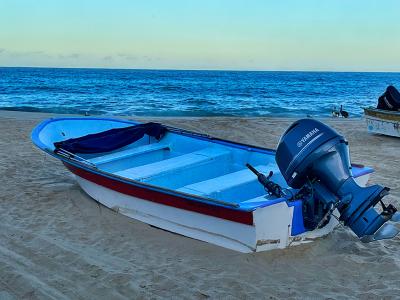.
Please read the following information before leaving for your expedition.
It provides the most accurate information available and will likely answer any questions you have about the project. You may also reach out to your Program Coordinator with any questions you may have.
Click on the images to view full size!
COVID-19 Safety
Please test for COVID-19 before traveling to your expedition; do not travel if you have tested positive, and call Earthwatch right away for the next steps. Visit earthwatch.org/covid-19 for more information on how you can help reduce the risk of COVID-19 impacting your expedition.
The Research
A massive expanse of unusually warm water, dubbed "the Blob," disrupted marine ecosystems along the West Coast in 2014. From toxic algal blooms to mass mortality events to food chain disruptions, this marine heatwave had far-reaching consequences that were still being felt years later. Extreme climatic events like this are becoming more common and intense, threatening a wide range of critical marine species.
These events can be difficult to study, as the effects can be diverse and spread out throughout the ecosystem. But one way to gain insights into how marine heatwaves are affecting marine ecosystems is to look carefully at the food chain. Large marine animals, known as marine megafauna, are excellent indicators of the ecosystem’s overall health, as they rely on the lower trophic levels for food, are long-lived, and reproduce slowly. Marine megafauna are the canaries in the marine coal mine; when these large animals are suffering, you know the whole ecosystem is in trouble.
This project will focus on studying bottlenose dolphins and whale sharks in an urbanized seascape, La Paz Bay, and humpback whales in the secluded North Pacific coastal area of Punta Lobos, Baja Peninsula to determine how extreme climatic events and other human influences are affecting the health of the local marine ecosystems.
This project will help researchers understand how different pressures are affecting the behavior and reproduction of marine megafauna. Changes in the marine megafauna’s composition and reproductive rate at the two study locations will give researchers insights into how climatic events and human pressures are affecting not only the populations of large animals but also the ecosystem as a whole.
This project will also investigate how increasing ecotourism impacts marine species. Researchers can help ensure the sustainability of ecotourism for whale sharks and the people who rely on it by assessing compliance with current regulations and examining how tourism activities affect whale shark behavior.
The data you collect will provide a baseline from which scientists can monitor changes in the ecosystem and corresponding changes in marine megafauna behavior. This dataset will enable managers to create protective regulations while ensuring that the ecotourism industry is kept sustainable. The main goal of this project is to ensure that marine ecosystems are kept healthy and viable for both wildlife and the humans whose livelihoods depend on them.
Sea of Giants: Marine Life in the Baja Peninsula
Research Aims
This research aims to assess bottlenose dolphin, whale shark, and humpback whale population sizes and structure, their behavioral patterns, and how they use their habitat. The research will also assess the impact of extreme climatic events on marine ecosystems as well as the compliance of whale shark tour operators to current regulations and the impact these tours have on whale shark behavior.
The information collected will help scientists develop conservation plans that will protect these ecosystems and ensure the economic benefits of ecotourism are kept sustainable.
- Objective 1: Determine the behavioral response of the local inshore dolphin population to the sprawling urbanization in La Paz Bay.
- Objective 2: Determine if variability in the sea surface temperature impacts the birth rate, survival rate, and calving interval for bottlenose dolphins.
- Objective 3: Investigate how humpback whales use the shelf-coastal habitat off Punta Lobos.
- Objective 4: Assess whether the behavior and habitat use of humpback whales is impacted by climatic events in their northern summer foraging areas.
- Objective 5: Determine whether approaching boats or swimmers impact the behavior of whale sharks.
- Objective 6: Determine whether tour operators are complying with provisions in the regulation of swimming and observation activities with whale sharks in La Paz Bay.
Sea of Giants: Marine Life in the Baja Peninsula
How You Will Help
This expedition will be split between two locations: La Paz Bay and Punta Lobos. At each location, volunteers will be assigned to assist researchers with boat-based and land-based surveys, rotating tasks to ensure all may participate in each activity. Surveys will aim to observe marine megafauna, take ID photos, and record behavior. When you first arrive, you’ll receive orientation and training on the research methods. In the following days, you’ll work on the following research tasks:
- Observing Dolphin & Whale Behavior. We will travel by motorboat to observe bottlenose dolphins and humpback whales. You’ll record the position of the groups with a GPS, collect environmental data, and observe the individuals while at a distance that allows for photo identification but minimizes behavioral disturbances. After photos are taken, a drone technician will collect videos of the focal groups. Volunteers will also record the respiratory patterns of the whales and dolphins, including how long they stay on the surface, how many times they blow air out of their blowhole and inhale (known as blows) while surfaced, and the time between blows. Volunteers may also record dolphin and whale vocalizations using a hydrophone.
- Collecting Photo Identification of Dolphins and Whales. Volunteers will take images of the individuals in the groups. In the case of dolphins, you’ll take images of the fin on their back, the dorsal fin, to identify and differentiate individuals within the group. For whale identification, the goal will be to capture a clear photo of the fluke (tail fin).
- Collecting Video Footage. While observing marine megafauna behavior, some volunteers will be assigned to take videos in two-minute intervals to capture recordings that will complement the in-situ behavioral observations. The behaviors in the videos can be used to confirm observations and respiratory rates for dolphins and whales.
- Recording Observations from Land-Based Stations. Volunteers will be posted at land-based observation points to locate dolphins, whales, and whale sharks using binoculars. Group size and behavior will be recorded alongside environmental data at set intervals. The land-based teams will record data and assist drone technicians as they capture video footage of focal groups and will provide information on animal location and movements to the boat-based team as they follow the animals on the water.
- Whale Shark Tour Simulation. Earthwatch volunteers will board the boats of local tour operators, assessing their compliance with whale shark tourism regulations throughout the experience. Volunteers will record data on how the boats approach a whale shark, observe whale shark behavior as the boat and swimmers approach, and collect environmental data.
- Collecting Photo Identification of Whale Sharks. Volunteers will spend part of one day in the water with whale sharks. They will use underwater cameras provided by the researchers to take photos of whale sharks that can be used to identify the individuals. The spotting and striping pattern between the last gill slit and the base of the dorsal fin is used for identification, so volunteers will try to photograph that area on both the right and left sides for each individual. (Dependent on weather and presence of whale sharks.)
- Analyzing Data. Volunteers will spend time helping sort through the videos and photographs collected while in the field, as well as mapping where groups of marine megafauna were spotted.
Note: All teams will work with dolphins; however, the presence of whale sharks and humpback whales at these locations is seasonal. Whale sharks aggregate between late September and February, with the observation season highly regulated by the Mexican Secretariat of Environment and Natural Resources (SEMARNAT) and contingent upon the presence of sharks in the area. Humpback whales migrate to the area between January and April. These are general patterns and vary from season to season. Sightings of any animal are not guaranteed.
Sea of Giants: Marine Life in the Baja Peninsula
Life in the Field
Daily Activities
Weather and research needs can lead to changes in the daily schedule. We appreciate your cooperation and understanding.
After arriving and settling into the field base, you will spend a day on training and orientation to the research objectives and survey methods. Field work will commence on Day 3.
A typical morning will begin with an early breakfast (7:00 to 7:45 a.m.) and a review of the day’s objectives. In general, three days will be committed to fieldwork near the accommodations in La Paz Bay, surveying dolphins and whale sharks. Approximately two days will be spent at the secondary field site at Punta Lobos, focusing on humpback whale surveys. Each day the team will be divided and tasked with either boat-based or land-based survey tasks, swapping on alternate days to ensure all are able to participate in each activity.
Participants will eat a packed lunch each day, either on the boat or in the field. You may be asked to assist with carrying research equipment—either to be loaded onto the boat or for setup at land-based observation stations. During boat-based surveys, each person will be assigned a specific task—such as handling video and photo equipment, recording instrument readings—such as GPS coordinates, or deploying a hydrophone to collect acoustical data. At land-based observation stations, participants will rotate between taking behavioral observations (using binoculars), collecting and entering environmental data, and assisting a drone technician in locating and capturing footage of animal groups. Participants may spend up to 8 hours in the field each day—inclusive of transport to and from field sites. The drive time between La Paz and the secondary field site at Punta Lobos is about 1.5 hours each way.
Once back at the field base, the late afternoon and evening will be spent on data processing and analysis. You will help to store photos and footage from the day’s surveys, work on photo identification of individuals using an existing reference database and enter other environmental and observational data. The team will eat dinner together, where a discussion on the day’s results and events and the impact on the current research-conservation project is encouraged.
During poor-weather days, participants will focus on data entry and analysis. A visit to the La Paz whale museum may also be arranged.
Teams will generally have one day reserved for a group recreational activity, which may include a visit to a local beach (such as the beautiful Balandra Beach), a day at Espíritu Santo Archipelago, or just exploring the mining towns in the outskirts of La Paz. Availability of activities will vary, and recreational time will be flexible, depending on the schedule of research.
Itinerary
- Day 1: Arrival, orientation & introductory presentations, dinner & walking tour of El Malecón de La Paz
- Day 2: Training on dolphin and whale behavioral sampling, & whale shark regulatory compliance assessments
- Days 3–4: Boat and land-based surveys of dolphins and whale sharks in La Paz Bay, afternoon data entry & analysis
- Days 5–6: Boat and land-based surveys of humpback whales at Punta Lobos, afternoon data entry & analysis
- Day 7: Recreational day
- Day 8: Boat and land-based surveys of dolphins and whale sharks in La Paz Bay, afternoon data entry & analysis, possible whale museum tour
- Day 9: Departure
Sea of Giants: Marine Life in the Baja Peninsula
Accommodations and Food
* Please note that not every expedition has couples’ or singles' accommodations available. Please call or email Earthwatch to check for availability prior to reserving your space(s) on the team.
Sleeping
Volunteers will stay at a small rental home (casita) in La Paz, just a short walk away from the beach. The casita has three bedrooms, each equipped with twin-sized beds. Participants will share a room with two to three same-gender teammates. Sheets, blankets, pillows, and bath towels are provided at the casita; however, participants are encouraged to bring an extra towel for bathroom, beach, and/or boat use. Couples' accommodations may be possible depending on the overall gender makeup of the team.
* Earthwatch will honor each person’s assertion of gender identity respectfully and without judgment. For both teen and adult teams, where logistics dictate single-sex accommodations or other facilities, participant placements will be made in accordance with the gender identity the participant specified on their Earthwatch Participant form and/or preferences indicated in discussions with Earthwatch.
Bathrooms
The casita has two full bathrooms, which will be shared between volunteers. One of these is ensuite, connected to one of the larger bedrooms, and the other is off the main hallway. Flush toilets and hot-water showers are available.
There is no bathroom on any of the boats used for fieldwork. The boats are small fishing vessels and do not have an inside cabin. There will be a bucket available for bathroom use in the event someone cannot wait for land. This is standard for small boats and routine for the crew. Everyone aboard will make sure to turn away and provide as much privacy as possible.
Electricity
Electricity in Mexico has a standard voltage of 127 volts and a standard frequency of 60 hertz—which is the same as in the U.S. and Canada. Type A and Type B plugs are used (as in the U.S.) You may charge electronic devices at the casita.
Personal Communications
There is cell reception at the accommodations. Please check with your service provider regarding coverage in Mexico. If desired, you may purchase a local SIM card on the evening of your arrival at El Malecón de La Paz. There is Wi-Fi available at the accommodations.
Please Note: Earthwatch encourages volunteers to minimize outgoing calls and immerse themselves in the experience; likewise, family and friends should restrict calls to urgent messages only. Emergency communications will be prioritized.
Distance to the Field Site
La Paz Bay: Teams will typically board the boat from the beach—less than a 1 km walk from the casita—when conducting surveys in La Paz Bay.
Punta Lobos, Todos Santos: The secondary field site at Punta Lobos—where humpback whale surveys are conducted—is about a 1.5-hour drive from the accommodations in La Paz. Boat-based surveys will depart from the beach, just a short walk from the parking lot. Those assigned to the land-based surveys will hike up to 2-hours uphill (2.5 km) to reach the observation points.
Food and Water
Breakfast and dinner will be prepared in-house each day by a local cook and served family-style at the casita. Packed lunches will be provided to be eaten on the boat or in the field. The menu will include a mix of international fare and Latin American cuisine.
Typical Meals
The following are examples of foods you may find in the field. Variety depends on availability. We appreciate your flexibility.
- Breakfast: Eggs & toast, arepas with cheese and meats, beans, and fresh fruits
- Lunch: Sandwiches, tuna/pasta salad, burritos
- Dinner: Chicken and rice, homemade stews, assorted pastas, and salads
- Snacks: Fresh options, such as carrots and fruits
- Beverages: Purified water will be available in jugs at the casita, and in the field, for participants to fill-up their reusable water bottles. Juice, coffee, and tea will be made available with breakfast and dinner.
Special Dietary Requirements
Please alert Earthwatch to any special dietary requirements (e.g., diabetes, lactose intolerance, nut, or other food allergies, vegetarian or vegan diets) as soon as possible, and note them in the space provided on your volunteer forms.
This expedition can accommodate most special diets with advanced notice—including vegetarian, vegan, gluten-free, and lactose-free diets. Those with highly specialized dietary restrictions or preferences are encouraged to bring supplementary snacks to complement the standard offerings.
Sea of Giants: Marine Life in the Baja Peninsula
Project Conditions
The information that follows is as accurate as possible, but please keep in mind that conditions may change.
The climate in La Paz during winter/spring is typically dry and mild. During January–April, average daily low temperatures generally range from 55–60 degrees Fahrenheit, and daily highs range from 75–85 degrees Fahrenheit. Precipitation is generally infrequent at this time of the year, though strong winds can cause rough sea conditions and disrupt field work. Field staff will closely monitor the marine forecast, and boat-based surveys will not be conducted under adverse conditions.
General Conditions
For weather and region-specific information, please visit Wunderground.com and search for your project location.
Sea of Giants: Marine Life in the Baja Peninsula
Essential Eligibility Requirements
All participants must be able to:
- Enjoy being outdoors most of the day in variable weather, in the potential presence of wild animals and insects.
- Spend long hours sitting on a boat (some may experience seasickness) for an average of 5 hours per day with only access to a bucket on the boat to relieve yourself for 3–4 days per team. Good balance is required to maneuver aboard small vessels with bench seating. Sea conditions can make boat rides bumpy—which may be uncomfortable for individuals with back problems.
- Comfortable entering/exiting a small boat from the beach in ankle-deep water. This includes the ability to step up and into the boat about 1m off the ground without the assistance of a ladder.
- Comfortable entering/exiting a small boat while at sea using a ladder (for whale shark snorkeling).
- You must be able to brace yourself during boat launches and surf landings onto the beach without a dock or pier. Landings may be uncomfortable for individuals with back and knee problems.
- Swim/snorkel for up to 30 minutes at a time in areas where it is impossible to stand on the bottom; total swimming distance of approx. 500 m per session.
- Utilize all snorkeling equipment recommended or required by industry standards, including mask, fins, snorkel, and a wetsuit.
- Hike 2 hours or 2.5 km (each way; uphill, then downhill) over rocky, uneven terrain in desert conditions to reach land-based observation points on 2–3 days during the team. A hilly, desert hike of 2.5 km is also required to reach the car park from the boat’s shore-landing point on these days.
- Tolerate 30°C (85°F) heat, strong sun, and dry desert conditions.
- Carry personal daily supplies such as lunch, water, and some small field equipment.
- Climb into and down out of a minibus and ride, seated with the seatbelt fastened, for up to 3 hours on 2–3 days during the team.
- Follow verbal and/or visual instructions independently or with the assistance of a companion.
- Take an active role in your safety by recognizing and avoiding hazards if and when they arise (including, but not limited to, those described in Earthwatch materials and safety briefings). Always comply with project staff instructions and recommended safety measures.
- Be able to effectively communicate to the staff if you are experiencing distress or need assistance.
- Be able to get along with a variety of people from different backgrounds and ages, often in close proximity, for the duration of your team.
- Be comfortable surrounded by a language and/or culture different from yours.
Sea of Giants: Marine Life in the Baja Peninsula
Health and Safety
Emergencies in the Field
A VHF radio will be present on each boat used to perform field work. Project staff members will carry mobile phones at all times while in the field, and a spare mobile phone will be stationed at the casita to be used for emergency communications.
Earthwatch has a 24-hour, 7-day-a-week emergency hotline number. Someone is always on call to respond to messages that come into our live answering service.
Immunizations & Travel Vaccinations
Please be sure your routine immunizations are up to date (for example, diphtheria, pertussis, tetanus, polio, measles, mumps, rubella, and varicella) and that you have the appropriate vaccinations for your travel destination. Medical decisions are the responsibility of each volunteer and their doctor. Visit the Center for Disease Control and Prevention or the World Health Organization for guidance on immunizations.
If traveling from countries or regions where yellow fever is endemic, you must have a certificate of vaccination.
Staying up to date with your COVID-19 vaccinations, including receiving booster doses, as applicable, is strongly encouraged.
Sea of Giants: Marine Life in the Baja Peninsula
Project Risks and Precautions
Road Transportation
Poor road conditions and landslides may be encountered. Only qualified drivers will transport volunteers in project vehicles, and such vehicles will be well-maintained. Seatbelts must always be worn. Volunteers are not permitted to drive, and there will be no driving at night, in heavy rain, or otherwise adverse conditions. A mobile phone and emergency equipment (water, first aid kit, spare tire/jack, etc.) will be carried in case of a breakdown.
Hiking
Hiking over hilly, uneven terrain and in desert conditions is required for land-based surveys, and there is a risk of sprains, strains, or breaks due to falling or tripping. Participants must wear well-worn hiking boots with good ankle support and should stick to the dirt trail as much as possible.
Heat
High temperatures and long days in the sun can cause sun exposure, dehydration, and sunburn. Participants should wear breathable clothes that cover their skin, reapply sunscreen throughout the day, and consistently drink water. A shade canopy will be provided at land-based observation stations. Participants must communicate with field staff if they are feeling unwell due to the sun and temperature.
Animals
Venomous snakes, including rattlesnakes, are found throughout Baja California Sur. Venomous insects, including bark scorpions and brown recluse spiders, are also present. Participants must exercise caution while hiking, wear long pants and closed-toed shoes, and avoid sitting on the ground or near rock crevices while at land-based observation stations.
Stray and semi-stray domestic animals, such as dogs and cats, are common in La Paz and the town of Todos Santos. Participants should never approach dogs or cats. In the event of a bite or scratch, the wound must be immediately thoroughly washed with soap and clean water, and a topical povidone-iodine solution or ethanol will be applied. They will then be immediately transported to medical care.
Mosquitos and other biting insects are present and carry a range of diseases, including Zika, dengue fever, leishmaniasis, Chaga's disease (American trypanosomiasis), Rocky Mountain spotted fever and malaria. Participants should wear insect repellent, long-sleeved shirts, and long pants, particularly during the evening hours.
Hazardous marine organisms are present in the areas in which fieldwork is conducted. Protective gear, including a long-sleeved rash vest/legging or a wetsuit, will be used during snorkeling activities to reduce the impact of stinging organisms, such as jellyfish and other small cnidarians. Participants should indicate if they have an anaphylactic reaction to insect stings and consult with their physician before participating to determine if a similar reaction might occur because of being stung by jellyfish or other marine organisms.
Stingrays are prevalent in La Paz Bay, and stingray injuries and envenomation can cause severe injury, infection, or more serious outcomes. Participants will be advised to wear appropriate footwear (i.e., water shoes or booties) and to shuffle their feet whenever wading in shallow water where stingrays may be present. Attacks by sharks and other large fish are extremely rare but possible. Volunteers are to exit the water in a calm manner in the event of an animal acting aggressively.
See additional risks and precautions for working with marine mammals in the sections below.
Swimming, Snorkeling, & Wading
Swimming & snorkeling alongside large marine animals (whale sharks) is a key part of the research objectives and carries inherent risk. While whale sharks are docile, filter-feeding creatures, a head-on collision—or strike by the large tail fin—could cause significant injury. Participants will be briefed on the risks and appropriate safety precautions before entering the water. A minimum distance of 2 meters (6 feet) will be maintained between the shark and swimmer at all times. Swimmers will be instructed to approach sharks from a parallel direction only (never head-on), and to maintain a parallel swimming position beside the whale shark, being always alert and aware of the location of the tail fin to avoid being inadvertently struck. Those who are not confident swimmers must wear life jackets. Participants should be reminded to listen vigilantly and comply with all instructions provided by the boat captain, whale shark snorkeling guide, and Earthwatch field staff both before and during the encounter. Participants must always remain near the guide and never swim off on their own.
Additional opportunities for swimming & snorkeling may be possible during the recreational time (this may include snorkeling with sea lions at Isla Espíritu Santo). Such activities can be physically demanding and carry inherent risks. Safety procedures are established to minimize the risk associated with swimming & snorkeling, and these are outlined during the safety briefing at the start of the expedition. Swimming/snorkeling is only done in calm seas in areas deemed appropriate by project staff. Participants must swim with a buddy. Note: The beach adjacent to the project accommodations may not be used for swimming due to hazardous conditions.
Teams may explore the mangrove ecosystems of La Paz Bay by wading in knee to hip-deep water. Water shoes, booties, or other appropriate footwear must be worn for this activity. Per the section above, stingrays are prevalent in La Paz Bay, and caution must be taken to shuffle through the sand (rather than lifting the feet) to avoid contact with stingrays.
Whale Surveys
Inherent to surveying humpback whale populations on this expedition is the following of whales from a small, approximately 7-meter (24-foot) boat. The boats used for surveys are local fishing boats—made of fiberglass and wood—and unequipped with modern electronics. Though highly unlikely, there is a risk that a breaching or surfacing whale could collide with the boat—causing significant injury, or even death. All whale surveys will be led by an experienced boat captain and a member of the project staff with strong knowledge of whale behavior. The qualified project staff will communicate closely with the boat captain during all whale surveys to ensure the direction and speed of the approach are appropriate and a safe following distance is maintained between whale and vessel at all times. Lifesaving equipment (including a throw ring) will be kept onboard, and life jackets must be worn at all times while on the boat.
Working on a Boat
All water-based activities, including dolphin, humpback whale, and whale shark surveys—will be conducted from small, approximately 7-meter (24-foot) boats. Some of these are small local fishing boats unequipped with modern electronics. There is a risk of injury—including sprains, strains, or breaks during launch and landing and/or during adverse sea conditions.
A variety of methods will be used to enter/exit research boats. These include:
- Shallow water beach entries/landings necessitating wading in ankle-deep water.
- Using a ladder to enter/exit the boat while in open water (for snorkeling activities)
- Launching with the assistance of tow vehicles and surf landing onto the beach. This is the method employed by the fisherman’s cooperative at Punta Lobos, an area that lacks dock or pier space and has limited infrastructure.
Hazards may result from falling overboard while the vehicle is in motion and/or slips/trips/falls due to the impact of beach launches and surf landings. Individuals with mobility or spinal conditions, back, knee, or hip problems, and those who are pregnant may face difficulties or discomfort when boarding the boat, during navigation under choppy sea conditions, or with beach launches and surf landings (which can have a high impact). These volunteers should carefully consider participation on this project.
Participants will be instructed on how to prepare for launches and landings—including adopting appropriate body and leg positioning as needed. Life jackets will be available to each participant and must always be worn when on board the boat. Appropriate fo
Personal Security
Crime in Mexico occurs at a high rate and can be violent, from random street crime to cartel-related attacks. Over the past year, U.S. citizens in Mexico have been victims of armed robbery, carjacking, extortion, homicide, kidnapping, pick-pocketing, and sexual assault. Increased levels of cartel-related violence have resulted in territorial disputes and targeted killings, injuring or killing innocent bystanders. Though the risk is lower than in other states, criminal activity and violence may occur throughout the state of Baja California Sur, and travelers are advised to exercise increased caution. No night driving should occur unless for emergencies. Participants should leave valuables at home and not display signs of wealth when in public areas. It is recommended to avoid walking alone in towns at night while traveling in Mexico. If withdrawing money from an ATM, be sure to do so only during daylight hours in locations inside shops or malls. Avoid crowded areas and city outskirts while in La Paz.
Environmental Hazards
Tropical storms in the Gulf of Mexico or along the Caribbean and Pacific Coast of Mexico occur between May and November and can produce heavy winds and rain resulting in flooding, landslides, damage to infrastructure, and disruption to travel. Earthwatch teams will not be scheduled during the tropical storm season. In the event of a hurricane or tropical storm during an Earthwatch team, participants are to remain indoors in a safe location and follow the advice of local authorities.
Mexico is in an active earthquake zone. Tsunamis may occur following significant earthquakes. Project staff will monitor local media and follow the guidance of local authorities in the event of an earthquake. If at the accommodations, participants will be instructed to proceed to the designated muster point indicated in the Emergency Response Plan.
Distance from Medical Care
It may take an hour or more to arrange transport and reach the hospital when performing field work in La Paz Bay. While working in Punta Lobos, it may take up to three hours to reach the nearest medical center—and longer to reach the nearest major hospital for treatment of significant injuries. If you have a chronic condition that could require immediate medical care (e.g., heart conditions, kidney problems, severe asthma, etc.), or if you are pregnant, please discuss your participation on this expedition with your physician.
COVID-19 Disease Risks
COVID-19 remains an evolving risk to communities and individuals around the world.
Earthwatch strongly encourages you to stay up to date with your vaccinations, including receiving booster doses if available, and to continue to limit your exposure before your program, such as wearing a mask during travel and frequently washing your hands. Persons with a higher risk of severe illness from COVID-19 should consult with their healthcare provider before participation.
If you, or another person on site, display symptoms of illness or test positive for COVID-19, you may be required to wear a mask, test for COVID-19, seek medical advice, isolate/quarantine on- or off-site, cease or limit participation in program activities, and/or take other precautions. If local conditions or recommendations from authorities change, additional requirements may be implemented.
If you must isolate or depart from a program due to COVID-19 or other illness, you will not be entitled to a refund of the contribution for the program, nor any expenses resulting from your participation in the program or a disruption of your travel plans. We strongly encourage you to purchase travel insurance that will cover this eventuality.
Other Diseases
Diseases present in Mexico include rabies, hepatitis, measles, typhoid, leptospirosis, avian/bird flu, hantavirus, tuberculosis, Zika, dengue fever, leishmaniasis, Chaga's disease (American trypanosomiasis), Rocky Mountain spotted fever and malaria. Please see the U.S. Centers for Disease Control and Prevention (cdc.gov) or the World Health Organization (who.int) websites for more information on these conditions and how to avoid them. You can decrease your risk of most diseases above by avoiding mosquito bites, practicing good hygiene, and drinking only bottled or filtered water when appropriate. If you feel ill once you return from your trip, make sure you inform your doctor that you have recently returned from a tropical region. A note on vaccinations and treatment: Malaria is not present in the project area.
Sea of Giants: Marine Life in the Baja Peninsula
Travel Planning
Rendezvous Location
Manuel Márquez de León International Airport (LAP), La Paz, Mexico
* Additional information will be provided by Earthwatch to meet your team. Please do not book travel arrangements such as flights until you have received additional information from Earthwatch.
About Your Destination
Earthwatch strongly recommends that travelers investigate their destination prior to departure. Familiarity with the destination’s entry/exit requirements, visas, local laws, and customs can go a long way to ensuring smooth travel. The U.S. Department of State's Traveler’s Checklist and Destination Guides are helpful resources. For LGBTI travelers, the U.S. Department of State's LGBTI Travelers page contains many useful tips and links.
Country and Project Entry Requirements
You are responsible for reviewing and abiding by your destination's entry/exit requirements.
Entry visa requirements differ by country of origin, layover, and destination and do change unexpectedly. For this reason, please confirm your visa requirements at the time of booking and again 90 days before travel. Please apply early for your visa (we recommend starting six months before the start of your expedition). Refunds will not be made for volunteers canceling due to not obtaining their visa in time to meet the team at the rendezvous. You can find up-to-date visa requirements at the following website: travisa.com.
If a visa is required, participants should apply for a TOURIST visa. Please note that obtaining a visa can take weeks or even months. We strongly recommend using a visa agency to expedite and simplify the process.
Sea of Giants: Marine Life in the Baja Peninsula
Resources
Articles
- Karczmarski, L., Huang, S. L., Or, C. K., Gui, D., Chan, S. C., Lin, W., ... & Wu, Y. (2016). Humpback dolphins in Hong Kong and the Pearl River Delta: status, threats, and conservation challenges. In Advances in marine biology (Vol. 73, pp. 27–64). Academic Press.
- Meager, J. J., Hawkins, E. R., Ansmann, I., & Parra, G. J. (2018). Long-term trends in habitat use and site fidelity by Australian humpback dolphins Sousa sahulensis in a near-urban embayment. Marine Ecology Progress Series, 603, 227-242.
- Félix, F., Zavala, M., & Centeno, R. (2019). Spatial distribution, social structure, and conservation threats of a small community of bottlenose dolphins, Tursiops truncates (Odontoceti: Delphinidae) in Ecuador. Revista de Biología Tropical, 67(4), 1059-1076.
- Montero-Quintana, A. N., Vázquez-Haikin, J. A., Merkling, T., Blanchard, P., & Osorio-Beristain, M. (2020). Ecotourism impacts on the behaviour of whale sharks: an experimental approach. Oryx, 54(2), 270-275.
- Whitehead, D. A., Petatan Ramirez, D., Olivier, D., Gonzalez Armas, R., Pancaldi, F., & Galvan‐Magana, F. (2019). Seasonal trends in whale shark Rhincodon typus sightings in an established tourism site in the Gulf of California, Mexico. Journal of Fish Biology, 95(3), 982-984.
- Petatán‐Ramírez, D., Whitehead, D. A., Guerrero‐Izquierdo, T., Ojeda‐Ruiz, M. A., & Becerril‐García, E. E. (2020). Habitat suitability of Rhincodon typus in three localities of the Gulf of California: Environmental drivers of seasonal aggregations. Journal of Fish Biology, 97(4), 1177-1186.
- Pelayo-González, L., Oviedo, L., Márquez-Artavia, A., Herra-Miranda, D., Pacheco-Polanco, J. D., Bessesen, B., & Guzmán, H. M. (2022). Habitat use of south-eastern Pacific humpback whales (Megaptera novaeangliae; Borowski 1781) in Golfo Dulce, Costa Rica. Marine and Freshwater Research, 73(12), 1465-1474.
- Pelayo-González, L., Herra-Miranda, D., Pacheco-Polanco, J. D., Guzmán, H. M., Goodman, S., & Oviedo, L. (2022). Decreases in encounter rate of endangered Northeast Pacific humpback whales in Southern Costa Rica: Possible changes in migration pattern due to warming events. Frontiers in Marine Science, 1699.
Books
- Sea of Cortez: A Leisurely Journal of Travel and Research (John Steinbeck)
- Baja California Peninsula 101: 101 Ways to Explore Baja (Giovanni Simeone—Reyna Jaime Felix)
- Off-Trail Adventures in Baja California: Exploring Landscapes and Geology on Gulf Shores and Islands (Markes E Johnson)
Field Guides
- Guide to Birds in Baja California, Sea of Cortez, & along the Pacific Coast: Mexico Pacific Coast Field Identification Guides by Rainforest Publications
- Guide to Marine Life in Baja California, Sea of Cortez, & along the Pacific Coast: Mexico Pacific Coast Field Identification Guides by Rainforest Publications
- Baja, Sea of Cortez Marine Mammal Guide: Mexico Pacific Coast Field Identification Guides by Rainforest Publications
Project-related Website
Literature Cited
- Gentemann, C. L., M. R. Fewings, and M. García‐Reyes (2017), Satellite sea surface temperatures along the West Coast of the United States during the 2014–2016 northeast Pacific marine heat wave, Geophys. Res. Lett., 44, 312– 319, doi:10.1002/2016GL071039.
- Pelayo-González, L., Oviedo, L., Márquez-Artavia, A., Herra-Miranda, D., Pacheco-Polanco, J. D., Bessesen, B., & Guzmán, H. M. (2022b). Habitat use of south-eastern Pacific humpback whales (Megaptera novaeangliae; Borowski 1781) in Golfo Dulce, Costa Rica. Marine and Freshwater Research
- Quiros, A. L. (2007). Tourist Compliance to a Code of Conduct and the Effects on Whale in Donsol, Philippines. Fisheries Research, 84(1), 102–108.
- Whitehead DA, Petatán-Ramírez D, Olivier D, González-Armas R, Pancaldi F, Galván-Magaña F (2019) Seasonal trends in whale shark Rhincodon typus sightings in an established tourism site in the Gulf of California. Mexico. J Fish Biol 95(3):982–984. https://doi. org/ 10. 1111/ jfb. 14106
- Wild S, Krützen M, Rankin RW, Hoppitt WJE, Gerber L and Allen SJ (2019). Long-term decline in survival and reproduction of dolphins following a marine heatwave. Current Biology 29, R239–R240
Sea of Giants: Marine Life in the Baja Peninsula
Sign up for the Earthwatch Newsletter
Be the first to know about new expeditions, stories from the field, and exciting Earthwatch news.
.
.
.
